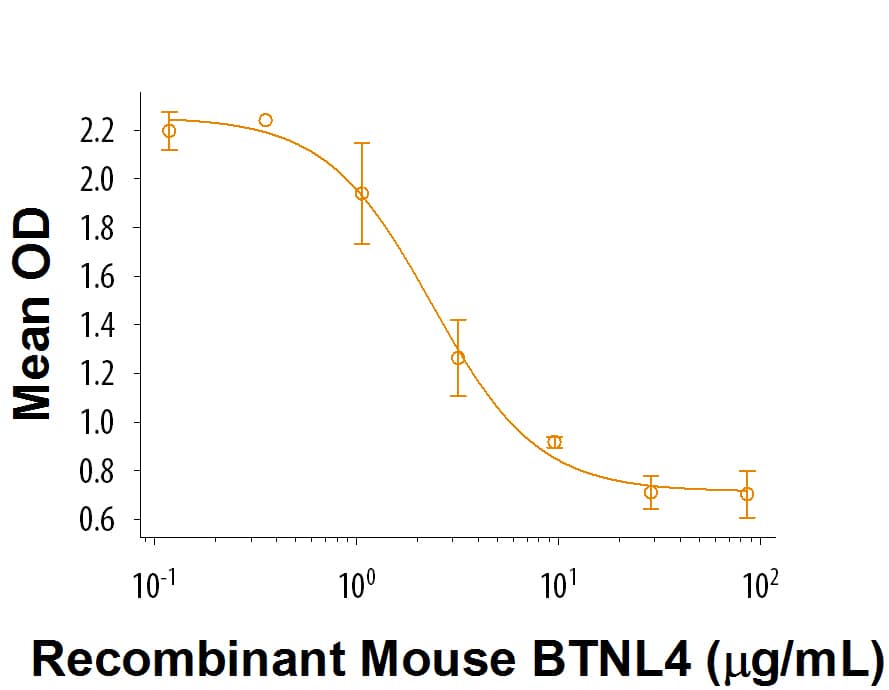Recombinant Mouse BTNL4 His-tag Protein, CF
R&D Systems, part of Bio-Techne | Catalog # 9594-BT

Key Product Details
Product Specifications
Source
Mouse myeloma cell line, NS0-derived mouse BTNL4 protein
Gln29-Trp250, with a C-terminal 6-His tag
Gln29-Trp250, with a C-terminal 6-His tag
Purity
>95%, by SDS-PAGE visualized with Silver Staining and quantitative densitometry by Coomassie® Blue Staining.
Endotoxin Level
<0.10 EU per 1 μg of the protein by the LAL method.
N-terminal Sequence Analysis
No results obtained. Gln29 inferred from enzymatic
pyroglutamate treatment revealing Glu30
Predicted Molecular Mass
26 kDa
SDS-PAGE
34-39 kDa, reducing conditions
Activity
Measured by its ability to inhibit IL-2 secretion by mouse T cells in the presence of anti-CD3.
The ED50 for this effect is 0.8-4 μg/mL.
The ED50 for this effect is 0.8-4 μg/mL.
Scientific Data Images for Recombinant Mouse BTNL4 His-tag Protein, CF
Recombinant Mouse BTNL4 His-tag Protein Bioactivity
Recombinant Mouse BTNL4 (Catalog # 9594-BT) inhibits IL-2 secretion by mouse T cells in the presence of anti-CD3 antibody. The ED50 for this effect is 0.8-4 μg/mL.Formulation, Preparation and Storage
9594-BT
| Formulation | Lyophilized from a 0.2 μm filtered solution in PBS. |
| Reconstitution |
Reconstitute at 200 μg/mL in PBS.
|
| Shipping | The product is shipped at ambient temperature. Upon receipt, store it immediately at the temperature recommended below. |
| Stability & Storage | Use a manual defrost freezer and avoid repeated freeze-thaw cycles.
|
Background: BTNL4
References
- Yamashiro, H. et al. (2010) J. Leukoc Biol. 88:757.
- Compte, E. et al. (2004) Eur. J. Immunol. 34:2089.
- Abeler-Dorner, L. et al. (2012) Trends Immunol. 33:34.
- Bas, A. et al. (2011) Proc Natl Acad Sci U S A. 108:4376.
Long Name
Butyrophilin-like 4
Alternate Names
BTN3A3, EG632126, NG11
Entrez Gene IDs
632126 (Mouse)
Gene Symbol
BTNL4
UniProt
Additional BTNL4 Products
Product Documents for Recombinant Mouse BTNL4 His-tag Protein, CF
Product Specific Notices for Recombinant Mouse BTNL4 His-tag Protein, CF
For research use only
